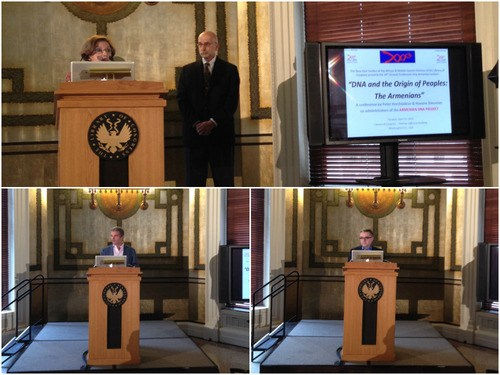
by Orsolya Doricsak
AAANews Blog
05/02/2014
Hovann Simonian and Peter Hrechdakian, administrators of the Armenian DNA Project, delivered the 18th Annual Vardanants Day Armenian Lecture, titled “DNA and the Origin of People: The Armenians” on Tuesday, April 22 at the Library of Congress, in Washington, DC.
By reaching thousands of years into the past, the project aims to find genetic traces of both the ancient peoples whose descendants make up the current Armenian population (including Colchians, Hattians, etc.) as well as the ancient peoples who conquered or passed through Armenian lands (such as Arabs, Turks, Cimmerians and Romans).
The major Armenian groups – haplogroups as they call them – came into existence about 20 thousand years ago, far before any ethnic or religious identification, according to Hrechdakian. Furthermore, based on the ancient DNA research, Armenians geographically originated from the area where they are living now, and throughout Eastern Anatolia (ancient Armenia).
Beyond the genetic map of the Armenians, which has been more or less identified, this research presents some method whereby the ethnic makeup of different nations can be compared. For instance, “Armenian DNA today most closely resembles Turks from Eastern Anatolia, Assyrians/Chaldeans and Mizrahi Jews (Kurdistant, Iraq, Azerbaijan and Georgia),” said Mr. Hrechdakian.
The DNA project worldwide started in the late 1990s. “The first paper on Armenian DNA was written in 2001 by Levon Yepiskoposyan, which is independent from our observation, that started in 2009. Since 2009, more than one thousand Armenians have joined the program, which is currently focused on formulating the DNA of Armenian subpopulations,” Mr. Hrechdakian said in his presentation.
As a Hungarian graduate student in Communication and Media Sciences, attending the lecture was a real intellectual inspiration, which motivated me to think about the relationship between the DNA project and the field of communications. Specifically, I am interested in more than the DNA project – which was started in Hungary 2 years ago. Some “Why?” questions might be answered through this approach or at least the theory might be a reliable aspect of divergence in communications.
If you are interested in getting tested, or to learn more about Armenian DNA, please visit the website of Armenian DNA Project and check out their Facebook Group.
Orsolya Doricsak is a graduate student studying Communication and Media Sciences at Corvinus University of Budapest, Hungary. She is currently doing a research at the Armenian Assembly of America in Washington, DC in international relations and political communications.
Comments